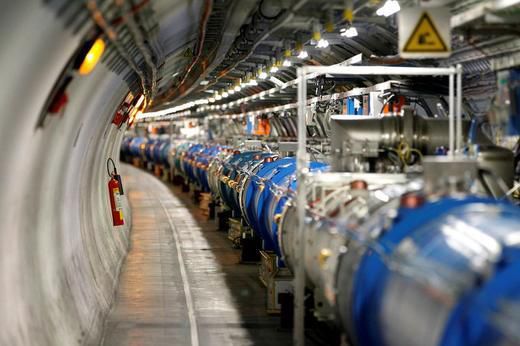Published
The standard model of particle physics fails to explain certain peculiarities of the W boson, a fundamental particle of matter.

An image of CERN, in Geneva.
Reuters
One of the fundamental particles of matter, the W boson, would have a larger mass than theory predicts, which would shake the « house of cards » of the Standard Model of particle physics, according to a study published Thursday in the journal « Science ».
« There are hints that some pieces are missing from the Standard Model, and we are bringing a new one, which is very interesting and quite important, » its lead author, Professor Ashutosh Kowtal, a physicist at Duke University in the United States, told AFP. .
Basis of radioactivity
This theory takes into account all the measurements made in the field of elementary particle physics, that is to say the world of the infinitely small, whose elements constitute the atoms and the forces that govern them. The Standard Model, finalized in the second half of the XXand century, makes it possible to « make fantastically accurate predictions » of the behavior of these particles, explains physicist Harry Cliff, at the University of Cambridge.
Like that of the W boson, a particle conveying in particular a so-called weak interaction, between other particles of matter. It is the basis of radioactivity and, beyond that, of nuclear fusion reactions, like those that drive the Sun. All these particles and forces find themselves linked in a kind of equilibrium. For example, the mass of the W boson is constrained by that of the Higgs boson.
« Extraordinary Affirmations »
“The Standard Model predicts an equilibrium, and the experimental result presented to us contradicts this prediction”, notes for AFP the physicist and research director at the CNRS Jan Stark. This “house of cards” falters with the study’s announcement that the mass of the W boson is stronger than expected. The feat of the CDF collaboration, a group of some 400 scientists led by the Pr Kowtal, is to have measured this mass, at 80,433 megaelectronvolts, with an unprecedented precision (0.01%), twice as great as the best existing.
It is the result of ten years of analysis on a sample of 4 million particles, produced in the Tevatron, a particle accelerator at Fermilab in the United States, now closed. This accelerator, like the LHC at CERN in Europe (which made it possible to identify the Higgs boson), causes particles to smash together at phenomenal speeds, revealing the elements that compose them by breaking them.
It is now up to another team, on another instrument, to confirm the result of this study to prove it. Because, as Jan Stark reminds us, “extraordinary assertions require extraordinary evidence”.
“Animated Discussions”
A major challenge, given the extreme precision of the measurement, which cannot be a matter of statistical chance. Therefore, « it’s either a major discovery or a problem in the analysis of the data », comments Jan Stark, who predicts « quite lively discussions in the years to come ».
The announcement of the CDF collaboration is the latest of « cracks that have been appearing for several years in the Standard Model, with precise measurements that contradict the predictions of the model », note the physicists and authors of another article in « Science « . If confirmed, this discovery could betray the existence of « new interactions or new particles », which today’s experiments are not yet able to reveal.
« A big thing in the infinitely big »
If physicists are thus looking for lice on the head of the Standard Model, it is because the latter is struggling in particular to explain « a great thing in the infinitely large », dark matter, according to Jan Stark, who directs the aptly named Laboratory des 2 infinis (L2IT), at Paul Sabatier University in Toulouse.
Several observations, such as the velocity of galaxies in galactic clusters or the abnormal speed of revolution of certain stars, have forced astrophysicists to theorize the existence of a hypothetical « dark matter » animating these phenomena. But nothing in the Standard Model explains which particle would make up this “dark matter”. “We follow the path, without neglecting any track. We will therefore end up understanding”, wants to believe the Pr Kotwal.
(AFP)

